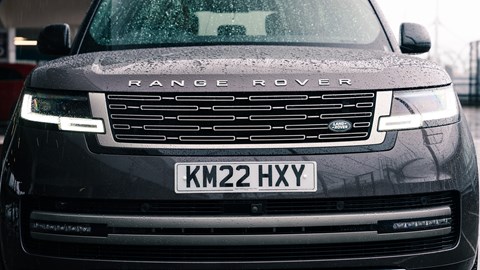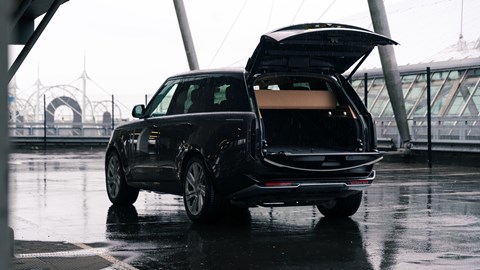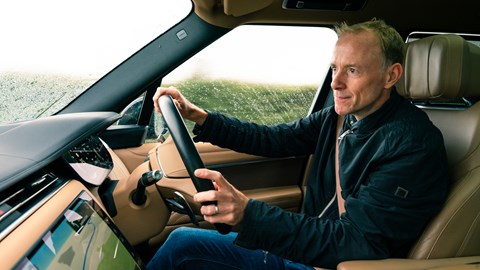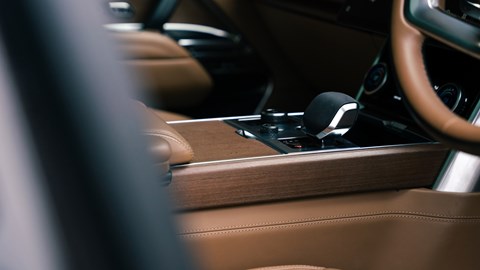► Sublime to drive and passenger in
► The planet cannot tolerate 207g/km of CO2
► Read month 1
Gliding down the motorway, three slumbering kids piled atop each other like fallen dominoes, the six-cylinder diesel murmuring gently as it drinks a gallon every 40 miles – this is a Range Rover’s comfort zone. But our time in the D350 in HSE spec is nigh.
Having not run a solely combustion-engined car since a 2018 Skoda Kodiaq, the prospect of a 2430kg SUV incapable of any zero-emissions electric miles as my daily transport made me uneasy.
Editor Miller reckons the mild-hybrid D350 is the pick of the current Range Rover powertrains: it’s torquey when roused, and economical too – we averaged just over 34mpg over seven months thanks to the current generation’s improved aerodynamics and the engine’s mild electric torque assistance. It also has a telepathic connection to the eight-speed ZF automatic transmission, making for silky smooth shifts.

All true. But it emits 207 grammes of CO2 for every kilometre travelled – not far off the P400 petrol’s 220g/km – so the all-electric Range Rover can’t come quickly enough.
And with its accommodating size and refinement focus, the Rangie is tailor-made to be an EV. There should be enough battery-stowage space in that chassis to avoid both range anxiety and compromising the epic 818-litre boot: family camping trips have never been so easy, recycling centre visits so infrequent.
Spending £650 on the boot floor partition (which if flipped can double as a backrest when you’re sitting on the tailgate) is worthwhile to prevent small items sliding into the void. But I’d suggest avoiding the auto-folding loadspace cover, which I could never fathom how to remove (the manual is useless), and which ultimately gave up auto-folding.
Dynamically, the Mk5 version, codenamed L460, is the best Range Rover ever.

One of this generation’s innovations, the standard-fit rear-wheel steering, is a revelation. This was brought vividly to life for me when it helped this huge car make a U-turn on a rural Essex track without becoming Austin Powers in that golf kart. Less obviously, the system brings welcome extra agility to every corner, working with the precision of the steering rack to turn the 4×4 nimbly into corners.
The new air suspension with twin-valve dampers banishes the excessive bodyroll of previous generations, boosting stability in curves: instead of feeling like you’re clinging on, this Rangie digs in and encourages you to feed in more power.
Not that the ride quality is compromised by the new suspension keeping roll in check: the trademark cushiness is present, but without compromising body control. High performance Range Rovers get an electronic roll-control system but the D350 doesn’t need it.

Not that our test car was short of options. With a glass roof panel fitted as standard, spending £545 to give the panel the ability to slide was pointless; I didn’t once feel the need to open it. Laminated front and rear glass (£275) combined with bulkheads designed to repel road noise and active noise cancellation made for an exquisitely calming cockpit. Hi-fi aficionados will appreciate the sublime Meridian sound system, others baulk at its £4435 price. It’s not as if the HSE trim level is poorly served as standard: it comes with an 800W, 19-speaker system. The upgrade is to a 1600W 35-speaker set-up that’s standard on Autobiography models.
Its windscreen pillar speaker combines with the big side mir- rors to create a blind spot capable of swallowing something as big as an Audi Q3 at a T-junc- tion: beware!
The kids loved the rear sunblinds (£550) and the parents loved the £980 four-zone cli- mate system: its touchscreen sub-menus may be complicated but the capability to lock the rear controls – to defuse fights over temperature and fan speed – was a blessing.
Boasting practicality, comfort, refinement and relative economy, this is peak Range Rover.
The uncluttered interior, with clear digital screens and minimal buttons, is easy on the eye and undemanding on the brain, unlike many a complex contemporary car. And it’s very easy to upgrade, with extended leather adding £1500, classy silver birch veneer another £385, plush £215 mats and £655 illuminated kickplates.

And that’s just the tip of the customisation iceberg and explains why it’s no effort for the wealthy to drop £200,000-plus on a Range Rover these days. They shouldn’t expect to get their money back: used-car valuation experts CAP reckon our £15k of options are worth £5k now, after seven months. But the basic car’s inherent desirability fends off overall depreciation well.
And desirable it is. Boasting image, practicality, comfort, refinement and relative economy, this is peak Range Rover. It’s a six-figure investment that’s worth every penny – and every member of this family will mourn its passing. Even the cat never seemed so relaxed when going to the vet’s.
Logbook: Range Rover D350 HSE (Month 4)
Price £113,120 (£128,180 as tested)
Performance 2997cc turbodiesel six-cylinder, 345bhp, 516lb ft, 6.1sec 0-62mph, 145mph
Efficiency 37.2mpg (official), 34.2mpg (tested), 207g/km CO2
Energy cost 22.0p per mile
Miles this month 397
Total miles 18,235
Count the cost
Cost new £128,180
Part exchange £87,750
Cost per mile 18.0p
Cost per mile including depreciation £1.08